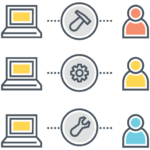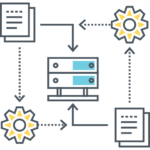Combine Technology with Psychology

Persuasive Patterns
Social Proof, Loss Aversion, Endowment Effect

Validation Patterns
A/B Testing, Mashup, High Hurdle

UI Patterns
Inplace Editor, Autocomplete, Playthrough
Gamify your Business

Achievements

Rewards

Leaderboards
Artificial Intelligence (AI)
Powered with machine learning (including its most advanced deep learning techniques), scanning huge amounts of data for dependencies and patterns to ultimately produce recommendations or provide a business with insights, thus contributing to data-driven decision-making.
Functional AI is very similar to analytic AI – it also scans huge amounts of data and searches for patterns and dependencies in it. However, instead of giving recommendations, functional AI takes action. For instance, being part of the IoT cloud, it can spot a machine-breakdown pattern in the sensor data received from a certain machine, and trigger a command to turn this machine off.
This type of AI allows businesses to automate communication without compromising on interactivity. To envisage this type of AI, think of chatbots and smart personal assistants whose abilities can vary from answering pre-built questions to understanding the conversation context.
Businesses that use text AI can enjoy text recognition, speech-to-text conversion, machine translation, and content generation capabilities. Even if a company is not Google or Amazon, or any other giant company that provides text AI as a service, it can still take advantage of this AI type.
With visual AI, businesses can identify, recognize, classify and sort objects or convert images and videos into insights and analytics. A computer system that helps an insurer estimate damage based on damaged car photos or a machine that grades apples based on their color and size are examples of visual AI.
Data Analytics
Using data aggregation and data mining to provide insight into the past and answer “What has happened?”
Helps you understand why something happened in the past and answers “Why it happened?”
Using statistical models and forecasting techniques to understand the future and answer “What could happen?”
Using optimization and simulation algorithms to advise on possible outcomes and answer “What should we do?”
